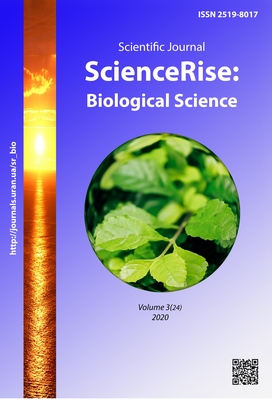Analysis of the influence of laser irradiation on the accumulation of biomass and polysaccharides pleurotus ostreatus (JACQ.) Р. Kumm
DOI:
https://doi.org/10.15587/2519-8025.2020.212509Keywords:
Pleurotus ostreatus, laser irradiation, surface cultivation, photoactivation, vegetative mycelium, polysaccharidesAbstract
The aim of the study was to investigate the effect of laser irradiation of mycelium on the amount of biomass and synthesis of P. ostreatus polysaccharides.
Materials and methods. For the study, 6 strains of P. ostreatus from the Collection of cultures of basidiomycetes of the Department of Botany and Ecology of Vasyl Stus DonNU were used. A device consisting of LED lasers was used for laser irradiation of vegetative mycelium: BRP – 3010–5, with red spectrum radiation with a wavelength of 635 nm; BBP – 3010–5 with blue spectrum radiation with a wavelength of 405 nm and BGP – 3010–5 with green spectrum radiation with a wavelength of 532 nm. The level of biomass accumulation was determined by weight. The polysaccharide content was determined by the phenol-sulfur method.
Results. The most effective was green light irradiation with a wavelength of 532 nm. For strain P-192 – the amount of biomass increased by 71.4 %. For strains P-191 and P-155 biomass increased by 60 % and 53.5 %. For strains P-108, P-154 and P-6v, the amount of biomass increased from 33.3 to 50 %. For strain P-192, the amount of mycelial endopolysaccharides increased by 42.0 %. For strains P-191 and P-6v, the amount of endopolysaccharides increased by 39.3 % and 38.7 %. For strains P-108, P-155 and P-154 the amount of mycelium endopolysaccharides increased from 30.7 % to 35.8. For strain P-192 the content of exopolysaccharides increased by 30.5 %. For strains P-154 and P-191, the amount of exopolysaccharides increased by 28.1 % and 27.8 %. For strains P-108, P-155 and P-6v the content of exopolysaccharides increased from 24.6 % to 25.8 %.
Conclusions. The most effective mode of photoactivation of P. ostreatus mycelium for obtaining target products was determined. In particular, the best response was observed in response to green light with a wavelength of 532 nm for strain P-192 – the amount of biomass increased by 71.4 %, the amount of mycelium endopolysaccharides increased by 42.0 %, and the content of exopolysaccharides increased by 30.5 %
References
- Belova, N. V., Denisova, N. P. (2005). Griby beloi gnili i vozmozhnost ikh ispolzovaniia dlia utilizatsii otkhodov. Biotekhnologiia, 4, 55–58.
- Dunaevskii, Ia. E., Dun Chzhan, Matveeva, A. R. et. al. (2006). Degradatsiia belkovykh substratov ksilotrofnymi bazidiomitsetami. Mikrobiologiia, 75 (1), 46–51.
- Patel, Y., Naraian, R., Singh, V. K. (2012). Medicinal properties of (Oyster mushroom): a review. World Journal of Fungal and Plant Biology, 3 (1), 1–12.
- Gern, R. M. M., Wisbeck, E., Rampinelli, J. R., Ninow, J. L., Furlan, S. A. (2008). Alternative medium for production of Pleurotus ostreatus biomass and potential antitumor polysaccharides. Bioresource Technology, 99 (1), 76–82. doi: http://doi.org/10.1016/j.biortech.2006.11.059
- Poedinok, N. L. (2015). Biotekhnologicheskie osnovy intensifikatsii kultivirovaniia sedobnykh i lekarstvennykh makromitsetov s pomoschiu sveta nizkoi intensivnosti. Kiev, 387.
- Reshetnyk, K., Prysedsky, Y., Yuskov, D. (2020). The influence of laser irradiation on the development of vegetative mycelium Pleurotus ostreatus. Biologija, 65 (4), 243–250. doi: http://doi.org/10.6001/biologija.v65i4.4118
- Mshandete, A. M., Mgonja, J. R. (2009). Submerged liquid fermentation of some Tanzanian Basidiomycetes for the production of mycelial biomass, exopolysaccharides and mycelium protein using wastes peels media. ARPN Journal of Agricultural and Biological Science, 4 (6), 1–13.
- Adebayo-Tayo, B. C., Jonathan, S. G., Egbomuche, R. C. (2011). Optimization of growth conditions for mycelial yield and exopolysaccharides production by Pleurotus ostreatus cultivated in Nigeria. African Journal of Microbiology Research, 5 (15), 2130–2138. doi: http://doi.org/10.5897/ajmr11.328
- Petre, M., Petre, V.; Petre, M. (Ed.) (2013). Environmental biotechnology for bioconversion of agricultural and forestry wastes into nutritive biomass. Enviromental biotechnology-new approaches and prospective applications. Croatia: InTech, 1–22. doi: http://doi.org/10.5772/55204
- Krupodorova, T. A., Barsteyn, V. Yu., Peshuk, L. V., Haschuk, O. I., Kostenko, E. E. (2014). Pleurotus ostreatus (Jacq.) Kumm. Cultivation on vegetable wastes. Biotechnologia Acta, 7 (4), 92–99. doi: http://doi.org/10.15407/biotech7.04.092
- Poyedinok, N. L. (2013). Use of artificial light in mushroom cultivation. Biotechnologia Acta, 6 (6), 58–70. doi: http://doi.org/10.15407/biotech6.06.058
- Dudka, I. A., Vasser, S. P., Ellanskaia, I. A. et. al. (1982). Metody eksperimentalnoi mikologii. Kyiv: Naukova dumka, 561.
- Varbanets, L. D., Zdorovenko, G. M., Knirel, Iu. A. (2006). Metody issledovaniia endotoksinov. Kyiv: Naukova dumka, 238.
- Prysedskyi, Yu. H. (1999). Statystychna obrobka rezultativ biolohichnykh eksperymentiv. Donetsk: Kassyopeia, 210.
- Prysedskyi, Yu. H. (2005). Paket prohram dlia provedennia statystychnoi obrobky rezultativ biolohichnykh eksperymentiv. Donetsk: DonNU, 84.
- Scherba, V. V., Babitskaya, V. G., Truchonovec, V. V., Fomina, V. I., Bisko, N. A., Mitropolskaya, N. Y. (1999). The Influence of the Cultivation Conditions on the Chemical Composition of Medicinal Mushrooms Pleurotus ostreatus (Jacq.: Fr.) Kumm. and Lentinus edodes (Berk.) Sing. International Journal of Medicinal Mushrooms, 1 (2), 181–185. doi: http://doi.org/10.1615/intjmedmushrooms.v1.i2.80
Downloads
Published
How to Cite
Issue
Section
License
Copyright (c) 2020 Kateryna Reshetnyk

This work is licensed under a Creative Commons Attribution 4.0 International License.
Our journal abides by the Creative Commons CC BY copyright rights and permissions for open access journals.
Authors, who are published in this journal, agree to the following conditions:
1. The authors reserve the right to authorship of the work and pass the first publication right of this work to the journal under the terms of a Creative Commons CC BY, which allows others to freely distribute the published research with the obligatory reference to the authors of the original work and the first publication of the work in this journal.
2. The authors have the right to conclude separate supplement agreements that relate to non-exclusive work distribution in the form in which it has been published by the journal (for example, to upload the work to the online storage of the journal or publish it as part of a monograph), provided that the reference to the first publication of the work in this journal is included.









